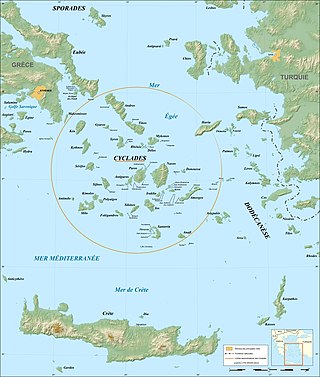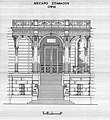
Athens is the capital and largest city of Greece. A major coastal urban area in the Mediterranean, Athens is also the capital of the Attica region and is the southernmost capital on the European mainland. With its urban area's population numbering over three million, it is the eighth largest urban area in the European Union. The Municipality of Athens, which constitutes a small administrative unit of the entire urban area, had a population of 643,452 (2021) within its official limits, and a land area of 38.96 km2 (15.04 sq mi).

Cycladic culture was a Bronze Age culture found throughout the islands of the Cyclades in the Aegean Sea. In chronological terms, it is a relative dating system for artifacts which serves as a roughly contemporary dating system to Helladic chronology and Minoan chronology (Crete) during the same period of time.

Greek art began in the Cycladic and Minoan civilization, and gave birth to Western classical art in the subsequent Geometric, Archaic and Classical periods. It absorbed influences of Eastern civilizations, of Roman art and its patrons, and the new religion of Orthodox Christianity in the Byzantine era and absorbed Italian and European ideas during the period of Romanticism, until the Modernist and Postmodernist. Greek art is mainly five forms: architecture, sculpture, painting, pottery and jewelry making.

The National Archaeological Museum in Athens houses some of the most important artifacts from a variety of archaeological locations around Greece from prehistory to late antiquity. It is considered one of the greatest museums in the world and contains the richest collection of Greek Antiquity artifacts worldwide. It is situated in the Exarcheia area in central Athens between Epirus Street, Bouboulinas Street and Tositsas Street while its entrance is on the Patission Street adjacent to the historical building of the Athens Polytechnic university.

Kolonaki, literally "Little Column", is an upscale neighborhood in central Athens, Greece. It is located on the southern slopes of Mount Lycabettus. Its name derives from the two metre column that defined the area even before the area's urbanization.

Tau-, Psi- and phi- type Greek terracotta figurines date back to 1450–1100 BC in Mycenaean Greece. They were typically small, made of terracotta, although a group of ivory figurines has been found, and were found in tombs, shrines and settlement areas. They are classified by their shape and a resemblance to the Greek letters of tau (τ), psi (ψ) and phi (Φ), according to a typological system created by Arne Furumark in 1941.

Ernst Moritz Theodor Ziller was a German-born university teacher and architect who later became a Greek national. In the late 19th and early 20th centuries, he was a major designer of royal and municipal buildings in Athens, Patras, and other Greek cities.

Vasilissis Sofias Avenue is a major avenue in the east side of the center of Athens, the Greek capital. The avenue was originally part of the Kifisias Avenue. The part from Syntagma Square to the intersection with Alexandras Avenue was renamed after Queen Sophia, the consort of King Constantine I. The avenue begins at the intersections of Amalias Avenue and Panepistimiou Street and ends by Alexandras, Kifissias and Mesogeion Avenues as well as Feidippou Street, with a total length of approximately 3 km. A section of the avenue is part of the old GR-1, and a branch of GR-54.
Niki Goulandris was a Greek philanthropist and an accomplished botanical painter.

The Nicholas P. Goulandris Foundation - Museum of Cycladic Art is a museum of Athens. It houses a notable collection of artifacts of Cycladic art.
Deste Foundation, Centre for Contemporary Art is an arts foundation in Nea Ionia, a northern suburb of Athens, Greece. Housing the art collection of Greek businessman Dakis Joannou, it organizes exhibitions with the collection and commissions new work by emerging and established international contemporary artists.

The Paul and Alexandra Canellopoulos Museum is a museum of antiquities in Athens, Greece. It is situated in the north slope of Acropolis, in the district of Plaka. Founded in 1976, it houses the collection of Paul and Alexandra Canellopoulos, which started being formed in 1923 and was donated to the Greek state in 1972. The collection features ca. 6500 items of Prehistoric, Ancient Greek, Byzantine and post-Byzantine art, spanning almost six millennia of history.

Athens Towers, is a complex of two buildings situated in Athens, Greece. Athens Tower 1 is 103 m (338 ft) and 28 storeys high, making it the tallest building in Greece, while Athens Tower 2 has 15 storeys and a height of 65 m (213 ft) being the 8th tallest in Greece.

Dionysiou Areopagitou Street is a pedestrianized street, adjacent to the south slope of the Acropolis in the Makrygianni district of Athens. It is named after Dionysius the Areopagite, the first Athenian convert to Christianity after Apostle Paul's sermon, according to the Acts of the Apostles, and patron saint of the city of Athens.
Ioannis S. "John" Coumantaros (1894–1981) was a Greek shipping and flour mills businessman.

The Goulandris Museum of Contemporary Art is a modern art museum in Eratosthenous Street, Pangrati, Athens, Greece, opened in October 2019. It displays many of the works amassed by shipowner Basil Goulandris and his wife Elise Karadontis, who died in 1994 and 2000 respectively, with an art collection valued at US$3 billion.

The following outline is provided as an overview of and topical guide to Athens:
Eleni Mylonas is a Greek-born American artist.

Petros Saroglos was a Greek military officer, collector and benefactor.





















